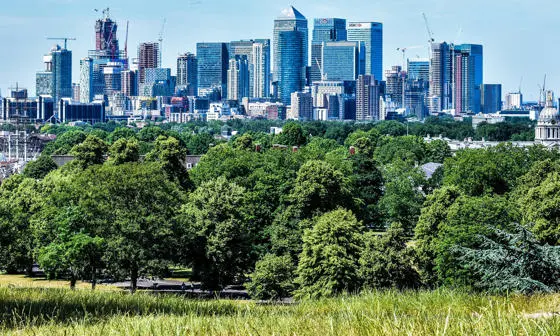Putting young people at the heart of local climate policy

Contents
The climate crisis is already reshaping societies around the world, and young people today are likely to see it intensify for decades to come. Yet despite being the generation most likely to suffer from climate change, only a small minority (just nine per cent of British 18–24-year-olds) feel they have a meaningful voice in shaping climate policy decisions (YouGov, 2023).
The Rethinking Green Transitions project, a year-long collaboration between LSE Cities, Islington Council and Partnership for Young London, set out to change that. Working with four young researchers from across the borough, the project explored how young people in Islington experience, understand and envision a fairer and greener future, as well as how climate action can better reflect their priorities.
Using youth-led peer research, the team engaged 158 young people and 20 policymakers to explore what makes a neighbourhood “liveable”, resulting in a report, published in summer 2025, that set out 10 practical recommendations including safer cycling and free bike provision, communications co-designed with young people and tailored climate education in order to make green transitions more inclusive, equitable and youth-led.
We’re at an overwhelming moment globally, I can understand why young people – or any of us – would feel overwhelmed by the state of the world.
Understanding local lives
The research focused on Islington, a London borough with stark inequalities in income, housing and access to green space. Imogen Hamilton-Jones, the project lead from LSE Cities, explains the origins of the project and some of the early findings: “In order to start talking about the green transition with young people, we used a scheme that Islington’s currently working on called Liveable Neighbourhoods. It was quite a holistic entry point, so the themes we discussed with young people were broad-ranging. We were asking questions like ‘what would make your neighbourhood a good place to make a life?’
“We talked about young people's travel habits – and what kind of barriers and opportunities they face around active travel – but we also talked about how young people connect to local places and people in a broader way: how they felt about getting to know their neighbours, whether they felt a sense of belonging in their neighbourhood. And then what liveability means to young people in relation to the bigger picture: what would a liveable planet for all look like, and how does that relate to green urban policy locally?
“We’re at an overwhelming moment globally, I can understand why young people – or any of us – would feel overwhelmed by the state of the world. I hope that by working together on a local level – and asking practical questions like ‘how would our streets look different in a greener, fairer world?’ – makes climate action feel more tangible.”
Youth-led research in action
For Hamilton-Jones, one of the defining features of Rethinking Green Transitions was its peer-led approach. Peer research is a form of Participatory Action Research which seeks to empower people affected by the issue being studied to design and lead the research. The four peer researchers, aged between 20 and 27, were trained in qualitative methods and took the lead in designing workshops, conducting interviews and analysing findings alongside the academic and policy team.
“If we're trying to understand young people's experiences of the borough and of the green transition, they need to be leading the conversation. At the same time, we wanted to build the skills of the team of young researchers we were working with.”
The council was also supportive of the researcher’s methods Hamilton-Jones went on to say: “Having a small team of policy officers from Islington Council joining all our research activities alongside the young people was great. It meant that the project was always rooted both in young people’s needs and also in the daily work of the council, so we could ensure policy relevance from the beginning. There's often a balance between having a totally open-ended participatory design and trying to ensure targeted policy impact. So sometimes the young people were making decisions based not only on their own interests but also on the opportunities for impact that they learnt about from the policy officers at the council.”
A lot of young people feel very insecure in Islington. They don't know if they'll be evicted from their housing or if they'll be able to afford to travel around the borough or to access amenities.
As the findings took shape, three central themes became clear: inequality; safety; and the desire among young people to engage with decision-making. In Islington, that meant focusing on the intersections between housing, transport, and access to public space.
“We found that 90 per cent of our survey respondents think that the green transition needs to address social and economic inequality. And that a programme like Liveable Neighbourhoods is undermined by quite systemic barriers to liveability like the cost of housing and the cost of transport.
“A lot of young people feel very insecure in Islington. They don't know if they'll be evicted from their housing or if they'll be able to afford to travel around the borough or to access amenities.’’ For many, climate action feels like a distant concern compared with the immediate pressures they face. More work needs to be done to make the links between climate justice and social, racial and economic justice for it to feel relevant.
Safety was the second major theme, particularly for women and non-binary young people. “People were worried about lighting and crime, bicycle theft was one of the huge barriers to cycling. Also road danger: people didn't want to be exposed to roads with big cars. But at the same time, slightly counterintuitively, this fear that young people were talking about on the streets was actually pushing lots of them to say that they'd like to own a car one day because they feel a car is a place of safety.”
Thirdly, the project revealed a strong desire among young people to engage with decision-making. “There is a real appetite [amongst young people to become involved in decision-making], and I did feel the creativity of all the young people we got together in focus groups and interviews. We found that 70 per cent of our survey respondents want more involvement in local decisions.
“However 38 per cent don't know where to start. There's a real communications gap, and a real lack of understanding of how local government works. One big recommendation is around education to improve that. There’s a need for deep participatory work to help young people gain a sense of ownership and agency. It means political education combined with actual decision-making power and long-term investment in collaborative programmes between young people and the council.”
We often talk about climate action having positive co-benefits ... But maybe we should start first with questions like: how could we re-make the local economy so that it meets people’s needs, creates community wealth and invests in young people?
Towards inclusive green transitions
The project produced 31 recommendations across 10 themes, all co-developed with young people and refined through workshops with council policymakers. They ranged from practical, low-cost interventions, such as mapping unsafe areas and co-designing climate communications with young people, to more ambitious proposals, including lobbying for rent controls and enhancing climate and political education. Several recommendations are already being implemented, with integration into Islington’s new child-friendly mission in development and youth councillors actively engaging with the council on next steps. The process has ensured that the recommendations are both actionable and capable of informing longer-term policy, showing a commitment to integrating youth voices into local climate decision-making.
Reflecting on the process, Hamilton-Jones says the project demonstrates what can happen when local governments take youth participation seriously. “We set out to bring young people's voices into the council, and into local public debates as well, and to have young people’s priorities reflected in Islington’s climate policy. Because the council has had this buy-in from the start, they are now really working through each of the 31 [recommendations] and trying to figure out what the next steps are, which feels really exciting.”
From local action to citywide change
Rethinking Green Transitions was published in summer 2025 and is available online, alongside an executive summary of the findings. The report has been received positively with an endorsement from the leader of Islington Council, an event at LSE Festival 2025 with Deputy Mayor for Energy and Environment, Mete Coban, a public launch event and local media attention.
Building on this success in Islington, the project team will begin to work with other London boroughs later in 2025. This next phase will involve bringing together a new team of young researchers to map youth engagement in climate policy across the city and then to convene a major event with young people and policymakers from across London's councils and the Greater London Authority (GLA), reflecting the desire from different levels of London local government to work on this issue.
Summing up the project’s broader implications, Hamilton-Jones suggests its impact reaches well beyond Islington: “I think a lot of the findings resonate with broader questions about how to frame green policy. We often talk about climate action having positive co-benefits, for example ‘climate action creates more jobs, more community spaces, more affordable energy’. But maybe we should start first with questions like: how could we re-make the local economy so that it meets people’s needs, creates community wealth and invests in young people? We need climate in all policymaking, but it shouldn’t always be the starting point.”
Imogen Hamilton-Jones was speaking to Helen Flood, Media Relations Manager at LSE.




